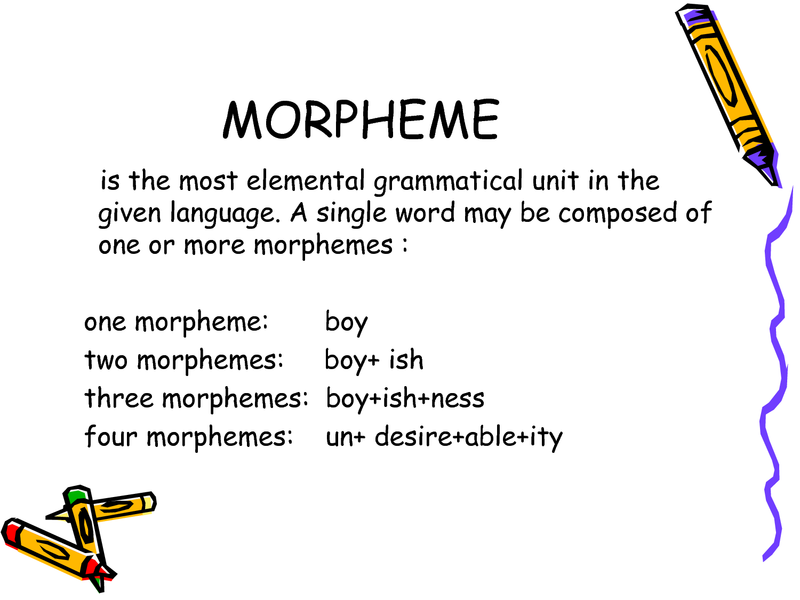المورفيم ( الوحدة الصرفية) Morpheme:
أصغر وحدة في علم الصرف Morphology ، أي أصغر جزئية لغوية تعطي معنى.
النظام الصرفي يتكون من:
1. وحدات صرفية ( مورفيمات): وهي أصغر وحدات لغوية ذات معنى.
2. علاقات تقابلية: تتحدد بها المعاني الوظيفية للوحدات الصرفية مثل معنى التأنيث والتثنية والجمع إلخ.
وتؤدي علاقات التقابل إلى ربط الوحدات الصرفية بمعانيها الوظيفية.
ففي الكلمات:
رجل – كتاب – مكتب – منضدة – كرسي
نلحظ أن كل كلمة منها تؤدي معنى، ولا نستطيع أن نحذف حرفا – أو صوتا- منها دون أن يختل المعنى، فكل منها يتكون من مورفيم واحد، أو وحدة صرفية واحدة.
أما في الكلمات:
رجلان – كتابان – مكتبان
فنجد أن الكلمة يمكن تقسيمها إلى جزءين:
أولهما يتكون من الاسم: ( رجل- كتاب- مكتب)، ويسمى وحدة صرفية حرة.
والثاني هو ( انِ) وهي وحدة صرفية تدل على المثنى، أي علامة التثنية في حالة الرفع.
وفي العبارات:
اشتريت منضدتين - جلست الفتاتان على كرسيين
نستطيع أن نقسم الجملة الأولى إلى وحدات أصغر، هي:
(اشترى) : وهي وحدة صرفية حرة تدل على الفعل.
( تُ ) : وهي وحدة صرفية تدل على الفاعل.
(منضدةَ) : وهي وحدة صرفية حرة ( اسم).
( يْنِ ) : وهي وحدة صرفية تدل على المثنى، أي علامة التثنية، في حالة النصب.
ونستطيع أن نقسم الجملة الثانية ( جلست الفتاتان على كرسيين ) إلى وحدات أصغر، هي:
( جلسَ ) : وحدة صرفية حرة تدل على الفعل.
( تْ ) : وحدة صرفية تتصل بالفعل تدل على التأنيث.
( ال ) : وحدة صرفية تدل على التعريف.
( فتا ) : وحدة صرفية حرة تدل على الاسم المفرد المذكر.
( تَ ) : وحدة صرفية تتصل بالاسم تدل على التأنيث.
( انِ ) : وحدة صرفية تدل على المثنى، في حالة الرفع.
(علَى) : وحدة صرفية حرة ( أداة ).
(كرسي) : وحدة صرفية حرة ( اسم).
( يْنِ) : وحدة صرفية تدل على المثنى، في حالة النصب.
وكذلك الحال في تقسيم الوحدات الصرفية للكلمات :
فلاحون – مسلمات – سيعملون
( فلاح ون ) / ( مسلم ات ) / ( س ي عمل ون )
Morpheme
In linguistics, a morpheme is the smallest semantically meaningful unit in a language. The field of study dedicated to morphemes is called morphology. A morpheme is not identical to a word, and the principal difference between the two is that a morpheme may or may not stand alone, whereas a word, by definition, is a freestanding unit of meaning. Every word comprises one or more morphemes.
Classification of morphemes
Free vs. bound
Every morpheme can be classified as either free or bound. These categories are mutually exclusive, and as such, a given morpheme will belong to exactly one of them.
Free morphemes can function independently as words (e.g. town, dog) and can appear with other lexemes (e.g. town hall, doghouse).
Bound morphemes appear only as parts of words, always in conjunction with a root and sometimes with other bound morphemes. For example, un- appears only accompanied by other morphemes to form a word. Most bound morphemes in English are affixes, particularly prefixes and suffixes, examples of suffixes are: tion, ation, ible, ing etc.. Bound morphemes that are not affixes are called cranberry morphemes, their nomenclature is derived from the bound, non-affix function of cran- in the word cranberry.
Derivational vs. inflectional
Bound morphemes can be further classified as derivational or inflectional.
Derivational morphemes, when combined with a root, change either the semantic meaning or part of speech of the affected word. For example, in the word happiness, the addition of the bound morpheme -ness to the root happy changes the word from an adjective (happy) to a noun (happiness). In the word unkind, un- functions as a derivational morpheme, for it inverts the meaning of the word formed by the root kind.
Inflectional morphemes modify a verb's tense or a noun's number without affecting the word's meaning or class. Examples of applying inflectional morphemes to words are adding -s to the root dog to form dogs and adding -ed to wait to form waited.
Allomorphs
Allomorphs are variants of a morpheme that differ in pronunciation but are semantically identical. For example, in English, the plural marker -(e)s of regular nouns can be pronounced /-z/, /-s/, or /-ɨz/, depending on the final sound of the noun's singular form
منقول






 رد مع اقتباس
رد مع اقتباس